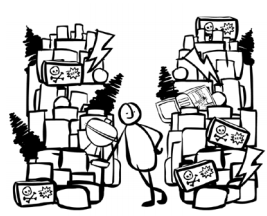Take a moment to think about the life of any object. It could be a water bottle, a pen, computer, etc… For the most part, the life of an object goes from “extraction to production to distribution to consumption to disposal” (“Story Of Stuff, Referenced and Annotated Script” 1). However, there is a slight problem with this consumerist process.
We use natural resources to manufacture these goods—natural resources derived from our little blue planet. Unfortunately, these resources are finite and will eventually run out. This is where the problem lies. The consumer industry involves making something then throwing it away. This process is only increasing. According to “Facts from The Story of Stuff,” the average person in the United States consumes twice as much as the average person fifty years ago. At this rate of acceleration of consumption and disposal, we will deprive future generations of the resources we indulge in.
Twenty-one and a half million tons of food waste are generated annually in the United States. Of course, natural decomposition helps out in getting rid of this waste. The trillions of bacteria thriving in our landfills consume the organic material rather quickly. If we were to compost this food, however, the amount greenhouse gases reduced would be the equivalent of “taking 2 million cars off the road” (“11 facts about recycling” 1). Although this would be a step towards sustainability, the world would still have a long way to go. There is no better time for the pursuit of resource sustainability.
There are countless statistics that push for sustainability, some of which are overwhelming. For example, we only have 4% of our original forests left. Yet, we are still destroying forests. Many wonder why such staggering statistics exist and why we are not doing much to change them. The answer is that humans as a whole do not like taking responsibility of their actions. One particular example is seen in Mary Shelley’s Frankenstein.
Many people are under the impression that Frankenstein is a book about a man who makes a monster. This, although true, fails to encompass the massive themes it emphasizes. One of these is that humans do not particularly enjoy taking responsibility of their actions. In the book, a man named Victor Frankenstein brings a corpse dubbed “The Creature” to life. Due to The Creature’s ugliness, Frankenstein flees and leaves it. Years later, the Creature comes back to terrorize Frankenstein. Following its creation, Frankenstein is constantly in a state of paranoia. In the latter part of the book, many deaths occur at the hand of The Creature. By the end of the book, Frankenstein’s closest friend and much of his family are dead, showing the consequences of his refusal to accept his responsibilities.
The increased pursuit of sustainability is an absolute necessity. There are many little things in our everyday lives that we barely have to change to be a few steps closer to a sustainable Earth, yet many choose not to. If we procrastinate in closing the resource loop of Earth, the future generations will not have anything left to use, and our little blue planet might no longer be blue in the future.
Works cited
“11 Facts About Recycling.” 11 Facts About Recycling. Dosomething.org, n.d. Web. 13 Apr. 2015. <https://www.dosomething.org/facts/11-facts-about-recycling>.
“Facts from The Story of Stuff.” (2007): 1-3. The STor. Web. 12 Apr. 2015. <http://storyofstuff.org//wp-content/uploads/movies/scripts/StoryofStuff_FactSheet.pdf>.
Leonard, Annie. “Story Of Stuff, Referenced and Annotated Script.” (2007): 1-16. The Story of Stuff. Web. 12 Apr. 2015. <http://storyofstuff.org/wp-content/uploads/movies/scripts/Story%20of%20Stuff.pdf>.
